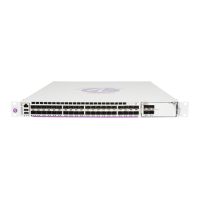Configuring IP Router Parameters
32 7705 SAR OS Router Configuration Guide
Autonomous Systems
Networks can be grouped into areas. An area is a collection of network segments within an
autonomous system (AS) that have been administratively assigned to the same group. An
area’s topology is concealed from the rest of the AS, which results in a significant reduction
in routing traffic.
Routing in the AS takes place on two levels, depending on whether the source and destination
of a packet reside in the same area (intra-area routing) or different areas (inter-area routing).
In intra-area routing, the packet is routed solely on information obtained within the area; no
routing information obtained from outside the area can be used. This protects intra-area
routing from the injection of bad routing information.
Routers that belong to more than one area are called area border routers. All routers in an AS
do not have an identical topological database. An area border router has a separate topological
database for each area it is connected to. Two routers, which are not area border routers,
belonging to the same area, have identical area topological databases.
Autonomous systems share routing information, such as routes to each destination and
information about the route or AS path, with other ASs using BGP. Routing tables contain
lists of next hops, reachable addresses, and associated path cost metrics to each router. BGP
uses the information and path attributes to compile a network topology.
DHCP
DHCP is a configuration protocol used to communicate network information and
configuration parameters from a DHCP server to a DHCP-aware client. DHCP is based on
the BOOTP protocol, with additional configuration options and the added capability of
allocating dynamic network addresses. DHCP-capable devices are also capable of handling
BOOTP messages.
A DHCP client is an IP-capable device (typically a computer or base station) that uses DHCP
to obtain configuration parameters such as a network address. A DHCP server is an Internet
host or router that returns configuration parameters to DHCP clients. A DHCP/BOOTP Relay
agent is a host or router that passes DHCP messages between clients and servers.
Note: Within the router context, the 7705 SAR supports IBGP but does not support EBGP.
Within the VPRN context, the 7705 SAR supports EBGP but does not support IBGP. For
information on configuring BGP within the router context, refer to the 7705 SAR OS Routing
Protocols Guide, “BGP”. For information on configuring BGP within the VPRN context, refer
to the 7705 SAR OS Services Guide, “VPRN Services”.

